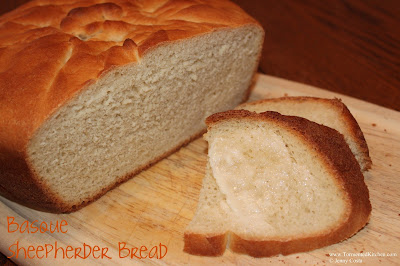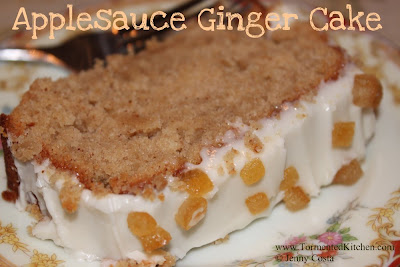Basque Sheepherder Bread
Lately, I have been in the mood for some foods that are a bit unusual. You could say we're tired of the same old thing. I started looking in cookbooks and asking around for ideas. One of my coworkers is in the Basque Library at UNR. She recently posted a link to some Basque recipes on their Facebook page. That got me thinking.
I went home and looked through the church fundraiser cookbooks, and asked Grandma Rose for ideas. I found some great stuff, like this bread. This recipe has been passed through the Winnemucca community and shared by a number of people, so I'm not sure who to credit.
I made a few small modifications to the recipe. For one, I don't have a gigantic cast iron Dutch Oven, so I cut the recipe in half. Two, as I was making it, I used slightly less flour than originally called for and kneaded it slightly less.
I think next time, I will use the stand mixer with a dough hook to mix and work the dough before I knead it. I'm getting a little bit weak when it comes to hand-mixing and kneading for long times.
Ingredients
1 1/2 cups very hot tap water
1/2 cup sugar
1 package (or 2 1/4 teaspoons) active dry yeast
1/4 cup butter
1 1/4 teaspoons salt
4 1/2 cups unbleached all-purpose flour
olive oil
Method
1. Combine hot water, butter, sugar and salt. Stir until the butter completely melts. Check the temperature. It should be about body temperature. (If it's too hot, it will kill the yeast.) Sprinkle the yeast on top. Give it a gentle stir so the yeast gets wet. Now let it proof about 10-15 minutes.
2. When the yeast is good and foamy, add 3 cups flour. Mix well. You can use a stand mixer with a dough hook or bread machine. I did it the hard way like the sheepherders would have done it. I mixed it by hand with a big wooden spoon. The dough will be wet and sticky at this point.
3. When that flour is mixed in completely, add 1 cup flour and mix again. The dough will be very stiff.
4. Next you will need to knead the dough. Use the remaining 1/2 cup of flour to dust the kneading board and dough. I like to sprinkle some flour on the board, knead a few times until it's worked in, then repeat. Continue sprinkling flour until the dough isn't sticky anymore and it starts to look smooth. The gluten should develop enough at this point to make the dough springy and resilient. Continue kneading then shape it into a ball. You should end up kneading about 10 minutes total.
5. Grease or lightly oil a mixing bowl. Put your dough in the bowl, turn it over so the oil gets on the whole piece of dough. Cover with plastic wrap and let it rise about 1 1/2 hours.
6. Punch down the dough. Place in a prepared 3 Qt. Dutch Oven or similar covered casserole dish. The Dutch Oven should be greased with a circle of foil placed in the bottom. Grease the lid, too. Cover and let the dough raise again for an hour. It may even raise enough to lift the lid about 1/2" or so.
7. Score a few marks on top of the bread. It's traditional to make a cross. Bake at 375F, with the lid on, for 12 minutes. Remove lid and continue baking 30-35 minutes or until golden brown.
8. Let the bread cool in the Dutch Oven a little while, the take it out and cool the rest on a rack. This hearty bread is slightly sweet, but goes well with either sweet or savory foods. It's great for sopping up stew. It doesn't immediately dissolve when it gets wet.
Don't forget, there are always traditions with food like this. According to lore, the sheepherder gives his first slice of bread to his loyal dog as a symbol of his importance. My doggies weren't so fortunate because the kids were waiting with baited breath for the first slice.
I went home and looked through the church fundraiser cookbooks, and asked Grandma Rose for ideas. I found some great stuff, like this bread. This recipe has been passed through the Winnemucca community and shared by a number of people, so I'm not sure who to credit.
I made a few small modifications to the recipe. For one, I don't have a gigantic cast iron Dutch Oven, so I cut the recipe in half. Two, as I was making it, I used slightly less flour than originally called for and kneaded it slightly less.
I think next time, I will use the stand mixer with a dough hook to mix and work the dough before I knead it. I'm getting a little bit weak when it comes to hand-mixing and kneading for long times.
Ingredients
1 1/2 cups very hot tap water
1/2 cup sugar
1 package (or 2 1/4 teaspoons) active dry yeast
1/4 cup butter
1 1/4 teaspoons salt
4 1/2 cups unbleached all-purpose flour
olive oil
Method
1. Combine hot water, butter, sugar and salt. Stir until the butter completely melts. Check the temperature. It should be about body temperature. (If it's too hot, it will kill the yeast.) Sprinkle the yeast on top. Give it a gentle stir so the yeast gets wet. Now let it proof about 10-15 minutes.
2. When the yeast is good and foamy, add 3 cups flour. Mix well. You can use a stand mixer with a dough hook or bread machine. I did it the hard way like the sheepherders would have done it. I mixed it by hand with a big wooden spoon. The dough will be wet and sticky at this point.
3. When that flour is mixed in completely, add 1 cup flour and mix again. The dough will be very stiff.
4. Next you will need to knead the dough. Use the remaining 1/2 cup of flour to dust the kneading board and dough. I like to sprinkle some flour on the board, knead a few times until it's worked in, then repeat. Continue sprinkling flour until the dough isn't sticky anymore and it starts to look smooth. The gluten should develop enough at this point to make the dough springy and resilient. Continue kneading then shape it into a ball. You should end up kneading about 10 minutes total.
5. Grease or lightly oil a mixing bowl. Put your dough in the bowl, turn it over so the oil gets on the whole piece of dough. Cover with plastic wrap and let it rise about 1 1/2 hours.
6. Punch down the dough. Place in a prepared 3 Qt. Dutch Oven or similar covered casserole dish. The Dutch Oven should be greased with a circle of foil placed in the bottom. Grease the lid, too. Cover and let the dough raise again for an hour. It may even raise enough to lift the lid about 1/2" or so.
7. Score a few marks on top of the bread. It's traditional to make a cross. Bake at 375F, with the lid on, for 12 minutes. Remove lid and continue baking 30-35 minutes or until golden brown.
8. Let the bread cool in the Dutch Oven a little while, the take it out and cool the rest on a rack. This hearty bread is slightly sweet, but goes well with either sweet or savory foods. It's great for sopping up stew. It doesn't immediately dissolve when it gets wet.
Don't forget, there are always traditions with food like this. According to lore, the sheepherder gives his first slice of bread to his loyal dog as a symbol of his importance. My doggies weren't so fortunate because the kids were waiting with baited breath for the first slice.














Comments
Post a Comment